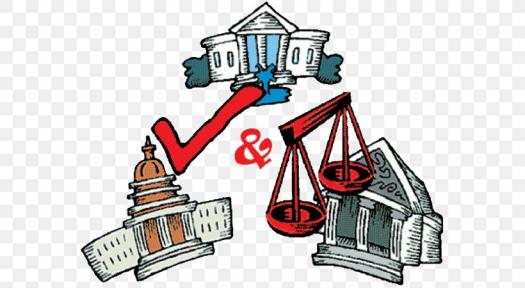Separation Of Powers Quiz

How much do you know about the Separation of Powers? Attempt this basic quiz to test your knowledge!
- 1.
Who is responsible for creating the Separation of Powers?
- A.
Russeau
- B.
Montesquieu
- C.
John Locke
- D.
Charles-Louis de Secondat
Correct Answer
B. MontesquieuExplanation
Montesquieu is responsible for creating the Separation of Powers. He was a French philosopher who proposed the concept of dividing political power into separate branches, namely the legislative, executive, and judicial branches. This idea was outlined in his influential work, "The Spirit of the Laws," published in 1748. Montesquieu argued that separating powers would prevent the concentration of power in a single individual or group, promoting a system of checks and balances. His ideas greatly influenced the development of modern democratic systems and the formation of constitutional governments.Rate this question:
-
- 2.
What are the three branches of the Separation of Power?
- A.
Executive, Legislative, Judging
- B.
Executive, Judicial, Legislative
- C.
President, Senate, Cabinet
- D.
Life, Liberty, and the Pursuit of Happiness
Correct Answer
B. Executive, Judicial, LegislativeExplanation
The three branches of the Separation of Power are the Executive, Judicial, and Legislative branches. The Executive branch is responsible for enforcing laws, the Judicial branch interprets laws and resolves disputes, and the Legislative branch makes laws. This system ensures a balance of power and prevents any one branch from becoming too powerful. The answer "Executive, Judicial, Legislative" correctly identifies these three branches.Rate this question:
-
- 3.
What are the President's advisors called?
- A.
Cabinet
- B.
Counter
- C.
The Box
- D.
Judicial Branch
Correct Answer
A. CabinetExplanation
The President's advisors are called the Cabinet. The Cabinet is a group of high-ranking officials from different government departments who provide advice and assistance to the President. They are responsible for making important policy decisions and implementing the President's agenda. The Cabinet members are appointed by the President and are typically experts in their respective fields. They play a crucial role in shaping and executing the President's policies and initiatives.Rate this question:
-
- 4.
Before it is a law, it is a...
- A.
Proposal
- B.
Bill
- C.
Amendment
- D.
Right
Correct Answer
B. BillExplanation
Before a proposed law becomes an official law, it goes through a legislative process. One of the stages in this process is the bill stage. A bill is a draft of a proposed law that is presented to the legislature for consideration and debate. It is during this stage that the bill undergoes scrutiny, amendments, and voting before it can be passed and enacted as a law. Therefore, the correct answer is "Bill."Rate this question:
-
- 5.
The ________ Branch makes the laws and is made up of two parts
Correct Answer
Legislative, legislativeExplanation
The answer is "Legislative, legislative" because the question is asking for the name of the branch that makes laws and is made up of two parts. The term "legislative" refers to the branch, and since it is mentioned twice in the answer, it indicates that there are two parts within the legislative branch.Rate this question:
- 6.
What is it called when one branch doesn't allow another to become too powerful?
- A.
Checking
- B.
Limited Government
- C.
Democracy
- D.
Checks and Balances
Correct Answer
D. Checks and BalancesExplanation
Checks and balances is the correct answer because it refers to a system where each branch of government has the ability to limit the power of the other branches. This ensures that no single branch becomes too powerful and prevents any abuse of power. It promotes a system of accountability and prevents any one branch from dominating the others.Rate this question:
-
- 7.
What can the President do if they do not like a law passed by the Legislative Branch?
- A.
Judicial Review
- B.
War
- C.
Presidential Veto
- D.
Impeachment
Correct Answer
C. Presidential VetoExplanation
The President can use a Presidential Veto if they do not like a law passed by the Legislative Branch. This means that the President can reject the law and send it back to Congress with their objections. Congress can then override the veto with a two-thirds majority vote in both the House of Representatives and the Senate, or they can make changes to the law to address the President's concerns. The Presidential Veto is a powerful tool that allows the President to influence the legislative process and prevent the passage of laws they disagree with.Rate this question:
-
- 8.
What two things are Congress made up of?
- A.
President
- B.
Cabinet
- C.
Senate
- D.
Vice-President
- E.
House of Representatives
Correct Answer(s)
C. Senate
E. House of RepresentativesExplanation
Congress is made up of two parts, the Senate and the House of Representatives. The Senate represents the states, with each state having two senators. The House of Representatives represents the people, with the number of representatives for each state based on its population. Together, the Senate and the House of Representatives make up the legislative branch of the United States government.Rate this question:
-
Quiz Review Timeline +
Our quizzes are rigorously reviewed, monitored and continuously updated by our expert board to maintain accuracy, relevance, and timeliness.
-
Current Version
-
Mar 21, 2023Quiz Edited by
ProProfs Editorial Team -
Feb 19, 2020Quiz Created by
Zach Burgess
 Back to top
Back to top





